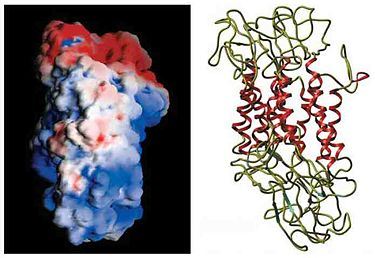Introduction of SLC6A3
SLC6A3 is encoded by SLC6A3 gene. It belongs to the solute carrier family 6 which has been extensively studied during the past few decades because it offers numerous possibilities for therapeutic applications. It is a norepinephrine transporter which can remove norepinephrine from synaptic cleft to cytosol, and is responsible for the regulation of the rewarding and motivational processes underlying food intake and eating behaviors. Meanwhile, many studies conducted on SLC6A3 show that it is related with various diseases, such as idiopathic epilepsy, attention-deficit hyperactivity disorder and tobacco addiction.
| Basic Information of SLC6A3 | |
| Protein Name | Sodium-dependent dopamine transporter |
| Gene Name | SLC6A3 |
| Aliases | DAT1 |
| Organism | Homo sapiens (Human) |
| UniProt ID | Q01959 |
| Transmembrane Times | 12 |
| Length (aa) | 620 |
| Sequence | MSKSKCSVGLMSSVVAPAKEPNAVGPKEVELILVKEQNGVQLTSSTLTNPRQSPVEAQDRETWGKKIDFLLSVIGFAVDLANVWRFPYLCYKNGGGAFLVPYLLFMVIAGMPLFYMELALGQFNREGAAGVWKICPILKGVGFTVILISLYVGFFYNVIIAWALHYLFSSFTTELPWIHCNNSWNSPNCSDAHPGDSSGDSSGLNDTFGTTPAAEYFERGVLHLHQSHGIDDLGPPRWQLTACLVLVIVLLYFSLWKGVKTSGKVVWITATMPYVVLTALLLRGVTLPGAIDGIRAYLSVDFYRLCEASVWIDAATQVCFSLGVGFGVLIAFSSYNKFTNNCYRDAIVTTSINSLTSFSSGFVVFSFLGYMAQKHSVPIGDVAKDGPGLIFIIYPEAIATLPLSSAWAVVFFIMLLTLGIDSAMGGMESVITGLIDEFQLLHRHRELFTLFIVLATFLLSLFCVTNGGIYVFTLLDHFAAGTSILFGVLIEAIGVAWFYGVGQFSDDIQQMTGQRPSLYWRLCWKLVSPCFLLFVVVVSIVTFRPPHYGAYIFPDWANALGWVIATSSMAMVPIYAAYKFCSLPGSFREKLAYAIAPEKDRELVDRGEVRQFTLRHWLKV |
Function of SLC6A3 Membrane Protein
SLC6A3, also named as dopamine transporter (DAT), is mainly expressed in the striatum. The SLC6A3 gene codes for a presynaptic transporter for uptake of dopamine, and thus affecting the amount of available dopamine in the synaptic cleft. Recent studies indicate that SLC6A3 variants are strongly associated with obesity features, metabolic profiles, and dietary intake. In addition, researches have confirmed several SLC6A3 SNPs could be potential therapeutic targets with the value in the early diagnosis and management of neurodevelopmental diseases in newborns.
 Fig.1 Structure of SLC6A3 membrane protein.
Fig.1 Structure of SLC6A3 membrane protein.
Application of SLC6A3 Membrane Protein in Literature
This article reports the association between the SLC6A3, DRD4 polymorphisms and body mass index in 232 Colombian young subjects. These results indicate that a significant association is found in these two genes and BMI in healthy young adults.
This article analyzes the relationship between DRD2, SLC6A3, and OXTR and cortisol secretion in anticipation of infant stress. These results indicate that DRD2, SLC6A3, and OXTR genetic characteristics are related to the maternal protective system and anticipatory cortisol secretion.
Authors in this group analyze the expression and methylation levels of SLC6A3 in white blood cells of full-term newborns. The data show that highly methylation of SLC6A3 gene is one of risk factors for attention-deficit/hyperactivity disorder.
This article conducts a meta-analyse to identify the association between SLC6A3 gene polymorphisms and methylphenidate in children with attention-deficit hyperactivity disorder (ADHD). The results suggest that SLC6A3 variants are strongly associated with severity of ADHD.
This article conducts a case-control study to detect the expression of SLC6A3 and the gene polymorphisms in patients who suffer from dopamine transporter deficiency syndrome. The data illustrate that SLC6A3 variants are associated with the risk of DTDS.
SLC6A3 Preparation Options
To obtain the soluble and functional target protein, the versatile Magic™ membrane protein production platform in Creative Biolabs enables many flexible options, from which you can always find a better match for your particular project. Aided by our versatile Magic™ anti-membrane protein antibody discovery platform, we also provide customized anti-SLC6A3 antibody development services.
As a forward-looking research institute as well as a leading custom service provider in the field of membrane protein, Creative Biolabs has won good reputation among our worldwide customers for successfully accomplishing numerous challenging projects including generation of many functional membrane proteins. Please feel free to contact us for more information.
All listed services and products are For Research Use Only. Do Not use in any diagnostic or therapeutic applications.